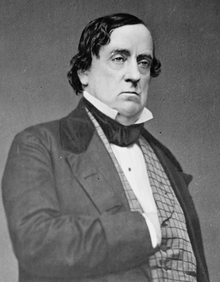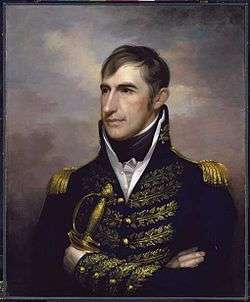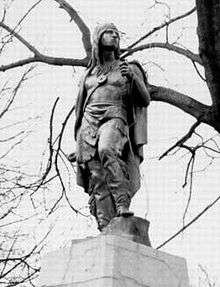Treaty of Greenville (1814)
The Treaty of Greenville (1814) was called A treaty of peace and friendship between the United States of America and the tribes of Native Americans called the Wyandots, Delawares, Shawanoese, Senacas and Miamies. It was concluded at Greenville, Ohio on July 22, 1814, to provide peace among the tribes, and with the U.S., as well as an alliance between these Tribes and the U.S. against Great Britain during the War of 1812.
Background
The earlier Treaty of Greenville, in 1795, followed the defeat of various native tribes at the Battle of Fallen Timbers and ended the Northwest Indian Wars. It involved extensive land concessions which became the U.S. state of Ohio, in exchange for payments of money and goods, and allowed peaceful American expansion and trade into the Northwest Territory. However, the border between Indian County and the United States did not hold; settlement pressure had continued, and several forts which initially appeared strategic American defenses against the British expanded from trading posts into settlements hubs.
Furthermore, various territorial (and state) governors had continued to negotiate for further land concessions, most notably Indiana's territorial (and later state) Governor William Henry Harrison (who negotiated the Treaty of Fort Wayne (1803) and the Treaty of Fort Wayne (1809), Governor William Clark of Missouri and Ninian Edwards of the Illinois Territory.
Tecumseh envisioned an alliance of many Native American tribes to exclude further white settlement. Other younger Native leaders, including Main Poc, Siggenauk and Chebanse excluded from treaty negotiations, also increasingly took matters into their own hands. Main Poc had been unconvinced by an 1808 meeting with outgoing President Thomas Jefferson, who had urged the chiefs to remain peaceful and prosper from farming instead of raiding, and did not attend the 1809 negotiations at Fort Wayne which increased payments to eastern Potawanomies in exchange concessions of lands claimed by the Miami Confederation.[1] The younger nativist warriors raided or attacked growing U.S. settlements including Vincennes, Kaskaskia, Fort Dearborn and even Fort Wayne by 1812.[2]
After meeting Tecumseh in July 1811, and realizing he and his warriors were heading south, Indiana's Territorial Governor Harrison had moved his family to Cincinnati, Ohio from Vincennes, then raised a military force. They first built Fort Harrison, then attacked Tecumseh's remaining warriors and their families at Prophetstown. After they sustained losses from a nighttime attack (Battle of Tippecanoe casualties included 68 soldiers killed as well as 50 Winnebago and Kickapoo warriors), Harrison's men torched the village and plundered its accumulated food stores in November 1811.[3]
This pattern of retaliation continued, and the American government tried to limit guns and ammunition available to the increasingly restive natives. However, they also needed both for hunting, and British traders tried to make up the difference, both for pecuniary reasons and to cement military alliances. Native raiders slaughtered ex-soldier settlers near Fort Dearborn in April 1812, shortly before the formal start of the War of 1812 between the British and Americans, and the abandoned fort itself was destroyed shortly after the Fort Dearborn Massacre during its evacuation on August 15, 1812. William Wells (who had helped negotiate the first and many other treaties as well as become the U.S. Indian Agent at Fort Wayne, only to be replaced by the new President Madison in favor of an inexperienced relative) died in that attack and soon his house and farm outside Fort Wayne were destroyed. However, the fort itself remained under U.S. control, as did did Fort Harrison and Fort Madison to the west.
Instead, Governor (now General) Harrison called out the militia and planned to attack native villages in Indiana and Michigan suspected of harboring anti-American warriors; Illinois' Territorial Governor Ninian Edwards did similarly. However, many of the torched villages had long been friendly to the Americans, including the home villages of Little Turtle, Five Medals and Black Partridge.[4]

Tecumseh died at the Battle of the Thames in Ontario, Canada in October 1813, and Commodore Oliver Perry won a significant naval victory about a month earlier which gave the Americans control of Lake Erie. In January 1814, Robert Forsyth and his band of traders, soldiers and interpreters captured British-allied traders at St. Joseph, Michigan, but they could not recapture Mackinac Island that summer.[5] Some western Potawatomi leaders pledged allegiance to the United States in St. Louis in late 1813, but the eastern native leaders were not persuaded to attend this second conference at Greenville with the governors of Michigan and Indiana in July 1814 until the British traders on whom they relied had been neutralized.[6]
Formal peace negotiations between the British and Americans would not begin for another year. The resulting Treaty of Ghent in February 1815 would return Mackinac Island to the United States and Fort Malden outside Detroit to the British.
Treaty Provisions
Article I established peace between the Miami, Potawatomi, Ottawa, and Kickapoo with the U.S., Wyandot, Delaware, Shawnee, and Seneca. Article II calls for the tribes to give aid to the U.S. in their war against Great Britain and her Native American allies, and not to make an independent peace. Article III has the tribes acknowledge themselves under the protection of the U.S., and no other power. In Article IV, the U.S. promises to respect their boundaries with the Native American Nations, established before the war, if the other conditions of the treaty are performed.[7]
Preamble
The said United States of America, by William Henry Harrison, late a major general in the army of the United States, and Lewis Cass, governor of the Michigan Territory, duly authorised and appointed commissioners for the purpose, and the said tribes, by their head men, chiefs, and warriors, assembled at Greenville, in the state of Ohio, have agreed to the following articles, which, when ratified by the president of the United States, by and with the consent of the Senate thereof, shall be binding upon them and the said tribes.
Article I
The United States and the Wyandots, Delawares, Shawanoese, and Senacas, give peace to the Miamie nation of Native Americans, formerly designated as the Miamie Eel River and Weea tribes; they extend this indulgence also to the bands of the Putawatimies, which adhere to the Grand Sachem Tobinipee, and to the chief Onoxa, to the Ottawas of Blanchard's creek, who have attached themselves to the Shawanoese tribe, and to such of the said tribe as adhere to the chief called the Wing, in the neighborhood of Detroit, and to the Kickapoos, under the direction of their chiefs who sign this treaty.
Article II
The tribes and bands abovementioned, engage to give their aid to the United States in prosecuting the war against Great-Britain, and such of the Native American tribes as still continue hostile; and to make no peace with either without the consent of the United States. The assistance herein stipulated for, is to consist of such number of their warriors from each tribe, as the president of the United States, or any officer having his authority therefor, may require.
Article III
The Wyandot tribe, and the Senecas of Sandusky and Stony Creek, the Delaware and Shawanoese tribes, who have preserved their fidelity to the United States throughout the war, again acknowledge themselves under the protection of the said states, and no other power whatever; and agree to aid the United States, in the manner stipulated in the former article, and to make no peace but with the consent of the said states.
Article IV
In the event of the faithful performance of the conditions of this treaty, the United States will confirm and establish all the boundaries between their lands and those of the Wyandots, Delawares, Shawanoese, and Miamies, as they existed previously to the commencement of the war.
IN TESTIMONY WHEREOF, the said commissioners and the said head men, chiefs, and warriors, of the beforementioned tribes of Native Americans, have hereunto set their hands and affixed their seals.
Done at Greenville, in the State of Ohio, this twenty-second day of July, in the year of our Lord one thousand eight hundred and fourteen, and of the Independence of the United States, the thirty-ninth.
Signatories for the United States
- WILLIAM HENRY HARRISON (Governor of Indiana),
- LEWIS CASS
Signatories for native peoples
Wyandots

- Tar-he, or crane
- Har-rone-yough, or Cherokee boy
- Te-ar-ront-ou-ose, or between the logs
- Men-ou-cou
- Rush-ar-ra, or Stookey
- Se-no-shus
- Zash-u-on-a, or big arm
- Te-an-dut-to-sooh, or punch
- Tah-uh-sough, or John Hicks
- Ron-oin-ness, or sky come down
- Tee-en-do
- Ron-ai-is
- Omaint-si-ar-rah, or Bowyer
- Tai-un-shrah, or Charles
- Ti-un-dra-ha, or John Bolisle
- E-lone-ni-rah, or shrone-she
Delawares

- Kick-to-he-nina, or Capt. Anderson
- Le-mot-te-nuck-ques, or James Nantioke
- La-o-pon-nichle, or Bauber
- Jo-on-queake, or John Queake
- Kill-buck
- Neach-corningd
- Montgomery Montaine
- Captain Buck
- Hop-hoo-que, or moles
- Captain White Eyes
- Captain Pipe
- McDaniel
- Captain Snap
Shawanoese
- Cut-e-we-cus-a, or black hoof
- Tam-e-ne-tha, or butter
- Pi-a-se-ka, or wolf
- Pom-tha, or walker
- Sha-mon-e-tho, or snake
- Pem-tha-ta, or turkey flying by
- We-tha-wak-a-sik-a, or yellow water
- Que-ta-wah, or sinking
- So-kut-che-mah, or frozen
- Wy-ne-pu-ech-sika, or Corn Stalk
- Chi-ach-ska, or captain Tom
- Qui-ta-we-peh, or captain Lewis
- Tea-was-koota, or Blue Jacket
- Tah-cum-tequah, or cross the water
Ottawas
- Wa-tash-ne-wa, or bear's legs
- Wa-pa-chek, or white fisher
- Too-ta-gen, or bell
- Augh-qua-nah-quo-se, or stump tail bear
- U-co-ke-nuh, or bear king
Senecas
- Coon-tind-nau, or coffee house
- Tog-won
- En-dosque-e-runt, or John Harris
- Can-ta-ra-tee-roo
- Cun-tah-ten-tuh-wa, or Big Turtle
- Ron-on-nesse, or wiping stick
- Co-rach-coon-ke, or reflection, or civil John
- Coon-au-ta-nah-coo
- See-is-ta-he, (black)
- Too-tee-an-dee, or Thomas Brand
- Hane-use-wa
- Ut-ta-wun-tus
- Lut-au-ques-on
Miamies
- Peoon
- La-passiere, or Ashe-non-quah
- Osage
- Na-to-wee-sa
- Me-she-ke-le-a-ta, or the big man
- Sa-na-mah-hon-ga, or Stone Eater
- Ne-she-peh-ta, or double tooth
- Me-too-sa-ni-a, or Indian
- Che-qui-a, or poor racoon
- Wa-pe-pe-cheka
- Chin-go-me-ga-eboe, or owl
- Ke-we-se-kong, or circular travelling
- Wa-pa-sa-ba-nah, or white racoon
- Che-ke-me-li-ne, or turtle's brother
- Pocon-do-qua, or crooked
- Che-que-ah, or poor racoon, a Wea, or little eyes
- Sho-wi-lin-ge-shua, or open hand
- O-ka-we-a, or porcupine
- Shaw-wa-noe
- Ma-uan-sa, or young wolf
- Me-shwa-wa, or wounded
- San-gwe-comya, or buffalo
- Pe-qui-a, or George
- Keel-swa, or sun
- Wab-se-a, or white skin
- Wan-se-pe-a, or sun rise
- An-ga-to-ka, or pile of wood
Potawatamies
- Too-pin-ne-pe
- O-nox-a, or Five Medals, of the Elkhart River band
- Me-te-a
- Con-ge, or bear's foot
- Na-nown-se-ca
- Cha-gobbe, or one who sees all over
- Meshon
- Penosh
- Che-ca-noe
- Nesh-coot-a-wa
- Ton-guish
- Ne-baugh-qua
- Ton-guish, a Chippeway
- Wes-nan-e-sa
- Che-chock, or crane
- Ke-poo-ta
- Mac-kor-ta, or crow
- Pu-pe-ketcha, or flat belly
Kickapoos
- Kee-too-te, or otter
- Ma-ko-ta-ne-cote, or black tree
- She-she-pa, or duck
- Wa-pe-kon-nia, or white blanket
- A-coo-che, or the man hung
- Che-kas-ka-ga-lon
In the presence of (the words "and the Wyandots, Delawares, Shawanoese, and Senecas," interlined in the first article before signing.) James Dill, Secretary of the commissioners. Jno. Johnson, Native American Agent. B. F. Stickney, Native American Agent. James J. Nisbet, Associate Justice of the Court of Common Pleas, Preble county. Thos. G. Gibson, Antoine Boindi, William Walker, William Conner, J. Bte. Chandonnai, Stephen Reeddeed, James Peltier, Joseph Bertrand, Sworn Interpreters. Thomas Ramsey, captain 1st rifle regiment. John Conner. John Riddle, col. 1st regiment Ohio militia.
To the Native American names are subjoined a mark and seal.